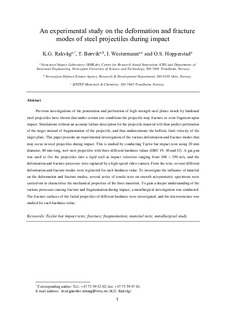| dc.contributor.author | Rakvåg, Knut Gaarder | |
| dc.contributor.author | Børvik, Tore | |
| dc.contributor.author | Westermann, Ida | |
| dc.contributor.author | Hopperstad, Odd Sture | |
| dc.date.accessioned | 2017-11-08T11:58:20Z | |
| dc.date.available | 2017-11-08T11:58:20Z | |
| dc.date.created | 2013-05-14T10:32:54Z | |
| dc.date.issued | 2013 | |
| dc.identifier.citation | Materials & Design. 2013, 51 242-256. | nb_NO |
| dc.identifier.issn | 0261-3069 | |
| dc.identifier.uri | http://hdl.handle.net/11250/2464923 | |
| dc.description.abstract | Previous investigations of the penetration and perforation of high-strength steel plates struck by hardened steel projectiles have shown that under certain test conditions the projectile may fracture or even fragment upon impact. Simulations without an accurate failure description for the projectile material will then predict perforation of the target instead of fragmentation of the projectile, and thus underestimate the ballistic limit velocity of the target plate. This paper presents an experimental investigation of the various deformation and fracture modes that may occur in steel projectiles during impact. This is studied by conducting Taylor bar impact tests using 20 mm diameter, 80 mm long, tool steel projectiles with three different hardness values (HRC 19, 40 and 52). A gas gun was used to fire the projectiles into a rigid wall at impact velocities ranging from 100 to 350 m/s, and the deformation and fracture processes were captured by a high-speed video camera. From the tests, several different deformation and fracture modes were registered for each hardness value. To investigate the influence of material on the deformation and fracture modes, several series of tensile tests on smooth axisymmetric specimens were carried out to characterise the mechanical properties of the three materials. To gain a deeper understanding of the various processes causing fracture and fragmentation during impact, a metallurgical investigation was conducted. The fracture surfaces of the failed projectiles of different hardness were investigated, and the microstructure was studied for each hardness value. | nb_NO |
| dc.language.iso | eng | nb_NO |
| dc.publisher | Elsevier | nb_NO |
| dc.rights | Attribution-NonCommercial-NoDerivatives 4.0 Internasjonal | * |
| dc.rights.uri | http://creativecommons.org/licenses/by-nc-nd/4.0/deed.no | * |
| dc.title | An experimental study on the deformation and fracture modes of steel projectiles during impact | nb_NO |
| dc.type | Journal article | nb_NO |
| dc.description.version | acceptedVersion | nb_NO |
| dc.source.pagenumber | 242-256 | nb_NO |
| dc.source.volume | 51 | nb_NO |
| dc.source.journal | Materials & Design | nb_NO |
| dc.identifier.doi | 10.1016/j.matdes.2013.04.036 | |
| dc.identifier.cristin | 1028367 | |
| dc.relation.project | Norges forskningsråd: 174834 | nb_NO |
| dc.description.localcode | © 2013. This is the authors’ accepted and refereed manuscript to the article. This manuscript version is made available under the CC-BY-NC-ND 4.0 license http://creativecommons.org/licenses/by-nc-nd/4.0/ | nb_NO |
| cristin.unitcode | 194,64,45,0 | |
| cristin.unitname | Institutt for konstruksjonsteknikk | |
| cristin.ispublished | true | |
| cristin.fulltext | postprint | |
| cristin.qualitycode | 0 | |

